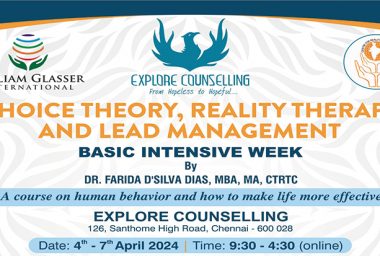-
Authoradmin
-
Comments0 Comments
-
Category
Stress can be painful and performance limiting for the most junior recruit to the most experienced senior executive in an organization. When employees perceive that their efforts are not matched by rewards they are found to be at risk of a host of stress related illnesses, including cardiovascular disease. Stress audit practices create awareness about the employees’ physical and psychological status and help to focus on providing employees with strategies and tools that can lead to personal as well as professional growth and development, better workplace relationships and less conflict and stress. The following real case study of Ms.Nanthini implies the need to have stress audit practices in organizations.
As people spend a large part of their time at work, the workplace is a crucial setting for action. It has been observed that interventions to improve individual capacity and to reduce stressors in the work environment increase population health and economic development. Employees tend to display a variety of emotional reactions regarding management decisions and behavior that, in their perception, have robbed them of a known way of life and work place security, and cast uncertain shadows on their future careers. While many of the external aspects of change happen according to schedule, the internal transition of an individual happens in a non- scheduled manner. For most people, the journey seems long, uncertain, tiring and very stressful.
Devastating Effects of Work Stress
We always emphasize the emotional impact of work stress and underplay the devastating effects it can have on cognitive functioning and on physical health. Recently, in a presentation at the University of South Australia, Professor Dick Dienstbier, University of Nebraska, stated that exposure to chronic work stress over time without sufficient opportunity for recovery leads to degradation of the hippocampus. This is a major problem not only for individuals but for knowledge organizations/ industries and especially knowledge economies, because the hippocampus is required for higher level cognitive functions.
Workers can be relied upon to know what local stressors are, and hearing others raise similar issues validates these concerns. Once identified, action needs to be taken to reduce the stressors, followed by feedback, and by evaluation to confirm reduction or to arrive at improvements in the process that need to be made. In the field this is referred to as the risk management approach (identify, assess, control).
When employees perceive that their efforts are not matched by rewards (including the old fashioned ‘you are doing a good job’) they are found to be at risk of a host of stress related illnesses, including cardiovascular disease (Seigrist, 1996). The following case is a typical example.
—————————————————————————————
* Counseling Psychologist, ICFAI Business school, Chennai.
Case Analysis of Ms. N
The following is a case study of a 40 year old Female who sought consultation for a variety of distressing physical symptoms which caused her great stress.
COMPLAINTS:
At the time of the first session the following complaints were noticed: – frustration, inability to concentrate, lethargy, low energy, lack of motivation, anger and sleep disturbances.
PROBLEM OVERVIEW:
Ms. N is a doctorate in information technology and was working as a chief moderator in a reputed company for the last 2 1/2 years. Her job profile required her to travel throughout India. She was always dedicated to her profession. She is a widow and has a son who stays in the hostel and is pursuing higher studies. So the company took advantage of this and without any prior notice they scheduled her outstation trips and forced her to comply with their instructions. When she would go out of Chennai she would work from 9am to 8pm. Due to continuous traveling and heavy work load she would often fall ill. When she expressed her difficulties to the Managing Director (MD) he did not attach any importance to them. That disturbed and troubled her a lot. Day by day she became physically and mentally weak and it went to such an extent that whenever she received calls from HQ she experienced fear, palpitations, anger, anxiety etc. She developed symptoms of cardiovascular disease. Unable to cope with the situation she applied for one month’s sick leave which was not sanctioned by the head quarters saying that it would affect their business. She felt that she was not given proper recognition by the employer and organization despite her dedication and hard work. So she decided to resign the job. After seeing her family doctor who could find no organic reason for her problems, on the advice of her Physician, she consulted a Psychologist to find out if stress could be a factor in her condition.
PERSONAL HISTORY:
Ms.N belonged to an upper middle class family. She got married at the age of 26 -and gave birth to a baby boy after one year. She lost her husband in a road accident after four years of marriage. As she had chosen her husband, she did not get any moral or financial support from her parents. She was working in a college which she had left and joined the present company 21/2 years ago.
GENERAL APPEARANCE AND BEHAVIOUR:
Ms. N was dressed neatly and hair was well groomed. She looked very calm. However she was a bit restless. She appeared to be unenergetic. Establishing rapport with her was very easy as she was friendly.
SPEECH :
Her speech was clear and she spoke slowly.
THOUGHT :
Her ideas and thoughts were well expressed. There appeared to be no evidence of blocks in her thought process. Her self-concept was good.
MOOD :
She looked sad and disturbed and expressed feelings of anger, hopelessness and despair.
MEMORY :
Her memory for remote and recent events was very good.
ORIENTATION :
She was well oriented to time, place and person.
INSIGHT :
She knew that she was going through some problem but was not confident of getting better.
PROVISIONAL ANALYSIS :
What follows is a Stress Audit conducted on Ms. N. Beck depression inventory and Incomplete sentence blank are the two psychological tools used to gain insight into Ms. N’s problems.
BECK DEPRESSION INVENTORY(BDI)
The BDI is a self-administered 21 item self-report scale measuring supposed manifestations of depression. The BDI takes approximately10 minutes to complete, although clients require a fifth – sixth grade reading age to adequately understand the questions. Each item has its specific interpretation as follows:
1. Sadness 12. Social withdrawal
2. Pessimism 13. Indecisiveness
3. Sense of failure 14 Change in body image
4. Dissatisfaction 15. Retardation
5. Guilt 16. Insomnia
6. Expectation of punishment 17. Fatigability
7. Self Dislike 18. Loss of appetite
8. Self Accusation 19. Loss of Weight
9. Suicidal ideation 20. Somatic preoccupation (preoccupation with body)
10. Episodes of crying 21. Low level of energy
11. Irritability
The score for each of the twenty-one questions are to be added up to obtain the total. The highest score on each of the twenty-one questions is three, the highest possible total for the whole test is sixty-three. The lowest possible score for the whole test is zero. Only one score per question is to be added (the highest rated if more than one is circled).
Scores of Ms. N as per her responses indicated that she was experiencing Mild to Moderate level of depression. It also suggested that she was experiencing feelings of Sadness (I am sad all the time and I can’t stand it), Social withdrawal (I am less interested in other people than I used to be), Pessimism (I am discouraged about the future), Indecisiveness (I put off decisions more than I used to), Dissatisfaction (I don’t enjoy things the way I used to), Insomnia (I wake up 1-2 hours earlier than usual and find it hard to get back to sleep), Episodes of crying (I cry more now than I used to), Somatic preoccupation (I am very worried about physical problems and it’s hard to think of much else(as per the tool)).
INCOMPLETE SENTENCE BLANK (annexure- 1)
The sentence completion method of studying personality is a semi-structured projective technique in which the subject is asked to finish a sentence for which the first word or words are supplied. It is assumed that the subject reflect her own wishes, desires, fears and attitudes in the sentences she makes.
It was seen from the responses that the client had given a total of 29 conflicting responses. That indicated an unhealthy and maladjusted frame of mind. It also indicated feelings such as hostility, pessimism, hopelessness etc.
A total of 9 positive responses indicated that she also had a positive attitude towards life. That gave hope for the therapist to work with the client.
Two of the responses were neutral ones. They were the responses not falling into the categories of either conflict responses or positive responses. Stereotype, catchy phrases and song titles were usually scored (as per the manual) as neutral responses. For instance, “Marriage is made in heaven”. Over-all the responses indicated the following:
The client’s relationship with her family was found to be unsatisfactory. This was revealed in the sentences “My father is always an authoritarian” and “A mother is concerned only about her husband”. She had fear and anxiety about her health and future.
She revealed feelings of anger and fear regarding the company, which was revealed in the sentences “My greatest fear is a phone call from the office.”, “I regret leaving my previous job.” and “what pains me is my M.D.’s attitude.” She nurtured intense grievance due to her job stress.
Psychological testing showed that she was a person prone to brooding and feelings of apprehension. She was under occupational stress. She never confides her worries to anyone. Her anxiety was compounded with depressive features. Stress which arose from her past occupation was the precipitating event for her problem. Because of this unpleasant situation in the family as well as at the work place she had become very stressed and depressed.
The case analysis of Ms. N can be summarized as follows in order to get a better picture regarding stress at the work place and its consequences.
|
Workplace stressors |
Thinking / Internal self-talk |
|
|
|
Effects Emotional
|
Physical
|
Psychological Management
She was asked to see her BDI score which indicated that she was experiencing moderate level of stress and was also asked to look at her responses to sentence completion test. Stress audit using psychological tools helped her to gain insight into her present problem. Counseling sessions helped her to achieve a more optimistic attitude towards life, to prepare her to face critical situations with courage, to become aware of her potential and to reduce her stress level by relaxation techniques like Music therapy. As she had learnt music and was very interested in music, music therapy was used to reduce her stress level and for her to become more relaxed. Music therapy helped her to express her inner feelings and this technique could also easily be practiced at her home.
The above case implies that absence of proper stress audit practices in the company where Ms. N was working was the cause for losing an efficient employer. Stress can be painful and performance limiting for the most junior recruit to the most experienced senior executive in an organization. Each organization must understand the need and importance of stress audit practices for their employers. Self-development helps one balance between inner and outer self. Development of inner qualities is a preparation for tasks that need to be done or roles to be performed in families, organizations and society. When self characteristics are congruent with the role requirement of the organization where he/she works, role enactment is more effective, proper and appropriate than when self and role are incongruent. Stress audit practices can help establishing the optimum congruency between self and roles. It prevents employees from becoming stressed out and helps them to become professionally renewed. Professional renewal incorporates the acquiring of skills for effective role enactment. This is a way of reflecting regularly what one has been doing and what could have been done to be effective in professional life. At the organizational level, strategies such as well-developed recruitment and selection processes incorporating psychometric assessment can ensure better job-person fit. This can be particularly effective in reducing the risk of psychological injury resulting from non-work factors such as personality styles that increase the likelihood of individuals becoming vulnerable to distress under certain circumstances.
Improving the quality of workplace relationships is also important in mitigating the risk of psychological injury and in helping individuals to recover from emotional distress and return to work. Relevant interventions for improving workplace relationships include training employees in improving individual communication, understanding and resolving differences, assertiveness and teamwork.Stress audit practices create awareness about the employees’ physical and psychological status and help to focus on providing employees with strategies and tools that can lead to professional growth and development, better workplace relationships and less conflict and stress.
References:
- www.swin.edu.au/victims/resources/assessment/affect/bdi
- Siegrist, J. (1996). Adverse health effects of high0effort/low reward conditions,
Journal of Occupational Health Psychology, 1(1), 27- 41. - In Psych (2006) the bulletin of the Australian Psychological society, 28(3),8-17
Leave A Comment Cancel reply
Recent Comments
Archives
- April 2024
- March 2024
- February 2024
- October 2023
- September 2023
- June 2023
- October 2022
- February 2022
- December 2021
- November 2021
- January 2021
- December 2020
- August 2020
- May 2020
- October 2019
- September 2019
- July 2019
- January 2019
- November 2018
- October 2018
- July 2018
- June 2018
- May 2018
- April 2018
- February 2018
- December 2017
- November 2017
- May 2017




